Neurochemical Effects of 4-(2Chloro-4-Fluorobenzyl)-3-(2-Thienyl)-1,2,4-Oxadiazol-5(4H)-One in the Pentylenetetrazole (PTZ)-Induced Epileptic Seizure Zebrafish Model
Abstract
1. Introduction
2. Results
2.1. Metabolic Neurotransmitters Alterations
2.2. Metabolic Neurosteroid Alterations
2.3. Protective Effect of GM-90432 on PTZ-Induced ROS Generation and Zebrafish Death
3. Discussion
4. Materials and Methods
4.1. Materials
4.2. Animals Care and Chemical Treatment
4.3. Analysis of Neurotransmitters in the Brain of Zebrafish
4.4. Analysis of Neurosteroids in the Brains of Zebrafish
4.5. Reactive Oxygen Species and Survival Assays
4.6. Statistical Analysis
5. Conclusions
Supplementary Materials
Author Contributions
Funding
Institutional Review Board Statement
Informed Consent Statement
Conflicts of Interest
References
- Moshé, S.L.; Perucca, E.; Ryvlin, P.; Tomson, T. Epilepsy: New advances. Lancet 2015, 385, 884–898. [Google Scholar] [CrossRef]
- Staley, K. Molecular mechanisms of epilepsy. Nat. Neurosci. 2015, 18, 367–372. [Google Scholar] [CrossRef] [PubMed]
- Cloix, J.-F.; Hévor, T. Epilepsy, regulation of brain energy metabolism and neurotransmission. Curr. Med. Chem. 2009, 16, 841–853. [Google Scholar] [CrossRef] [PubMed]
- Meldrum, B.S. Neurotransmission in epilepsy. Epilepsia 1995, 36, 30–35. [Google Scholar] [CrossRef] [PubMed]
- Snyder, S.H. Drug and neurotransmitter receptors in the brain. Science 1984, 224, 22–31. [Google Scholar] [CrossRef]
- Fonnum, F. Glutamate: A neurotransmitter in mammalian brain. J. Neurochem. 1984, 42, 1–11. [Google Scholar] [CrossRef]
- Cremer, C.M.; Palomero-Gallagher, N.; Bidmon, H.J.; Schleicher, A.; Speckmann, E.J.; Zilles, K. Pentylenetetrazole-induced seizures affect binding site densities for GABA, glutamate and adenosine receptors in the rat brain. Neuroscience 2009, 163, 490–499. [Google Scholar] [CrossRef]
- Dhir, A. Pentylenetetrazol (PTZ) kindling model of epilepsy. Curr. Protoc. Neurosci. 2012, 58, 9.37.1–9.37.12. [Google Scholar] [CrossRef]
- Greenfield, L.J., Jr. Molecular mechanisms of antiseizure drug activity at GABAA receptors. Seizure 2013, 22, 589–600. [Google Scholar] [CrossRef]
- Treiman, D.M. GABAergic mechanisms in epilepsy. Epilepsia 2001, 42, 8–12. [Google Scholar] [CrossRef] [PubMed]
- Evans, R.M. The steroid and thyroid hormone receptor superfamily. Science 1988, 240, 889–895. [Google Scholar] [CrossRef] [PubMed]
- Rupprecht, R.; Holsboer, F. Neuroactive steroids: Mechanisms of action and neuropsychopharmacological perspectives. Trends Neurosci. 1999, 22, 410–416. [Google Scholar] [CrossRef]
- Belelli, D.; Lambert, J.J. Neurosteroids: Endogenous regulators of the GABA(A) receptor. Nat. Rev. Neurosci. 2005, 6, 565–575. [Google Scholar] [CrossRef] [PubMed]
- Majewska, M.D.; Harrison, N.L.; Schwartz, R.D.; Barker, J.L.; Paul, S.M. Steroid hormone metabolites are barbiturate-like modulators of the GABA receptor. Science 1986, 232, 1004–1007. [Google Scholar] [CrossRef]
- Paul, S.M.; Purdy, R.H. Neuroactive steroids. FASEB J. 1992, 6, 2311–2322. [Google Scholar] [CrossRef]
- Wetzel, C.H.; Hermann, B.; Behl, C.; Pestel, E.; Rammes, G.; Zieglgansberger, W.; Holsboer, F.; Rupprecht, R. Functional antagonism of gonadal steroids at the 5-hydroxytryptamine type 3 receptor. Mol. Endocrinol. 1998, 12, 1441–1451. [Google Scholar] [CrossRef]
- Harden, C.L. Hormone replacement therapy: Will it affect seizure control and AED levels? Seizure 2008, 17, 176–180. [Google Scholar] [CrossRef][Green Version]
- Velisek, L.; Nebieridze, N.; Chachua, T.; Veliskova, J. Anti-seizure medications and estradiol for neuroprotection in epilepsy: The 2013 update. Recent Pat. CNS Drug Discov. 2013, 8, 24–41. [Google Scholar] [CrossRef]
- Loscher, W. Critical review of current animal models of seizures and epilepsy used in the discovery and development of new antiepileptic drugs. Seizure 2011, 20, 359–368. [Google Scholar] [CrossRef]
- Rashid, D.; Panda, B.P.; Vohora, D. Reduced estradiol synthesis by letrozole, an aromatase inhibitor, is protective against development of pentylenetetrazole-induced kindling in mice. Neurochem. Int. 2015, 90, 271–274. [Google Scholar] [CrossRef]
- Guo, S. Linking genes to brain, behavior and neurological diseases: What can we learn from zebrafish? Genes Brain Behav. 2004, 3, 63–74. [Google Scholar] [CrossRef] [PubMed]
- Kalueff, A.V.; Stewart, A.M.; Gerlai, R. Zebrafish as an emerging model for studying complex brain disorders. Trends Pharmacol. Sci. 2014, 35, 63–75. [Google Scholar] [CrossRef] [PubMed]
- Liu, J.; Baraban, S.C. Network properties revealed during multi-scale calcium imaging of seizure activity in zebrafish. eNeuro 2019, 6. [Google Scholar] [CrossRef] [PubMed]
- Hwang, K.-S.; Kan, H.; Kim, S.S.; Chae, J.S.; Yang, J.Y.; Shin, D.-S.; Ahn, S.H.; Ahn, J.H.; Cho, J.-H.; Jang, I.-S. Efficacy and pharmacokinetics evaluation of 4-(2-chloro-4-fluorobenzyl)-3-(2-thienyl)-1,2,4-oxadiazol-5(4H)-one (GM-90432) as an anti-seizure agent. Neurochem. Int. 2020, 141, 104870. [Google Scholar] [CrossRef]
- Rahn, J.J.; Bestman, J.E.; Josey, B.J.; Inks, E.S.; Stackley, K.D.; Rogers, C.E.; Chou, C.J.; Chan, S.S. Novel vitamin K analogs suppress seizures in zebrafish and mouse models of epilepsy. Neuroscience 2014, 259, 142–154. [Google Scholar] [CrossRef]
- Copmans, D.; Orellana-Paucar, A.M.; Steurs, G.; Zhang, Y.; Ny, A.; Foubert, K.; Exarchou, V.; Siekierska, A.; Kim, Y.; De Borggraeve, W. Methylated flavonoids as anti-seizure agents: Naringenin 4′,7-dimethyl ether attenuates epileptic seizures in zebrafish and mouse models. Neurochem. Int. 2018, 112, 124–133. [Google Scholar] [CrossRef]
- Sourbron, J.; Schneider, H.; Kecskés, A.L.; Liu, Y.; Buening, E.M.; Lagae, L.; Smolders, I.; de Witte, P. Serotonergic modulation as effective treatment for Dravet syndrome in a zebrafish mutant model. ACS Chem. Neurosci. 2016, 7, 588–598. [Google Scholar] [CrossRef]
- Gawel, K.; Langlois, M.; Martins, T.; van der Ent, W.; Tiraboschi, E.; Jacmin, M.; Crawford, A.D.; Esguerra, C.V. Seizing the moment: Zebrafish epilepsy models. Neurosci. Biobehav. Rev. 2020, 116, 1–20. [Google Scholar] [CrossRef]
- Cho, S.-J.; Byun, D.; Nam, T.-S.; Choi, S.-Y.; Lee, B.-G.; Kim, M.-K.; Kim, S. Zebrafish as an animal model in epilepsy studies with multichannel EEG recordings. Sci. Rep. 2017, 7, 3099. [Google Scholar] [CrossRef]
- Gawel, K.; Kukula-Koch, W.; Nieoczym, D.; Stepnik, K.; Ent, W.V.D.; Banono, N.S.; Tarabasz, D.; Turski, W.A.; Esguerra, C.V. The Influence of Palmatine Isolated from Berberis sibirica Radix on Pentylenetetrazole-Induced Seizures in Zebrafish. Cells 2020, 9, 1233. [Google Scholar] [CrossRef]
- Danysz, W.; Parsons, C.G.; Bresink, I.; Quack, G. Glutamate in CNS disorders. Drug News Perspect. 1995, 8, 261. [Google Scholar]
- McEntee, W.J.; Crook, T.H. Serotonin, memory, and the aging brain. Psychopharmacology 1991, 103, 143–149. [Google Scholar] [CrossRef] [PubMed]
- Xu, Y.; Yan, J.; Zhou, P.; Li, J.; Gao, H.; Xia, Y.; Wang, Q. Neurotransmitter receptors and cognitive dysfunction in Alzheimer’s disease and Parkinson’s disease. Prog. Neurobiol. 2012, 97, 1–13. [Google Scholar] [CrossRef]
- Ferrie, C.; Bird, S.; Tilling, K.; Maisey, M.; Chapman, A.; Robinson, R. Plasma amino acids in childhood epileptic encephalopathies. Epilepsy Res. 1999, 34, 221–229. [Google Scholar] [CrossRef]
- Huxtable, R.; Laird, H.; Lippincott, S.; Walson, P. Epilepsy and the concentrations of plasma amino acids in humans. Neurochem. Int. 1983, 5, 125–135. [Google Scholar] [CrossRef]
- Rainesalo, S.; Keränen, T.; Palmio, J.; Peltola, J.; Oja, S.S.; Saransaari, P. Plasma and cerebrospinal fluid amino acids in epileptic patients. Neurochem. Res. 2004, 29, 319–324. [Google Scholar] [CrossRef]
- Sheffler, D.J.; Williams, R.; Bridges, T.M.; Xiang, Z.; Kane, A.S.; Byun, N.E.; Jadhav, S.; Mock, M.M.; Zheng, F.; Lewis, L.M. A novel selective muscarinic acetylcholine receptor subtype 1 antagonist reduces seizures without impairing hippocampus-dependent learning. Mol. Pharmacol. 2009, 76, 356–368. [Google Scholar] [CrossRef]
- Kow, R.L.; Jiang, K.; Naydenov, A.V.; Le, J.H.; Stella, N.; Nathanson, N.M. Modulation of pilocarpine-induced seizures by cannabinoid receptor 1. PLoS ONE 2014, 9, e95922. [Google Scholar] [CrossRef][Green Version]
- Friedman, A.; Behrens, C.J.; Heinemann, U. Cholinergic dysfunction in temporal lobe epilepsy. Epilepsia 2007, 48, 126–130. [Google Scholar] [CrossRef]
- Jope, R.S.; Gu, X. Seizures increase acetylcholine and choline concentrations in rat brain regions. Neurochem. Res. 1991, 16, 1219–1226. [Google Scholar] [CrossRef]
- Starr, M.S. The role of dopamine in epilepsy. Synapse 1996, 22, 159–194. [Google Scholar] [CrossRef]
- Bozzi, Y.; Vallone, D.; Borrelli, E. Neuroprotective role of dopamine against hippocampal cell death. J. Neurosci. 2000, 20, 8643–8649. [Google Scholar] [CrossRef] [PubMed]
- Meurs, A.; Clinckers, R.; Ebinger, G.; Michotte, Y.; Smolders, I. Seizure activity and changes in hippocampal extracellular glutamate, GABA, dopamine and serotonin. Epilepsy Res. 2008, 78, 50–59. [Google Scholar] [CrossRef]
- Cifelli, P.; Grace, A.A. Pilocarpine-induced temporal lobe epilepsy in the rat is associated with increased dopamine neuron activity. Int. J. Neuropsychopharmacol. 2012, 15, 957–964. [Google Scholar] [CrossRef] [PubMed]
- Ruhnau, J.; Tennigkeit, J.; Ceesay, S.; Koppe, C.; Muszelewski, M.; Grothe, S.; Flöel, A.; Suesse, M.; Dressel, A.; Von Podewils, F. Immune Alterations Following Neurological Disorders: A Comparison of Stroke and Seizures. Front. Neurol. 2020, 11, 425. [Google Scholar] [CrossRef]
- Meldrum, B. Excitatory amino acid transmitters in epilepsy. Epilepsia 1991, 32, S1–S3. [Google Scholar] [CrossRef] [PubMed]
- Hamid, H.; Kanner, A.M. Should antidepressant drugs of the selective serotonin reuptake inhibitor family be tested as antiepileptic drugs? Epilepsy Behav. 2013, 26, 261–265. [Google Scholar] [CrossRef]
- Montgomery, S. Antidepressants and seizures: Emphasis on newer agents and clinical implications. Int. J. Clin. Pract. 2005, 59, 1435–1440. [Google Scholar] [CrossRef]
- Szymczyk, G.; Zebrowska-Lupina, I. Influence of antiepileptics on efficacy of antidepressant drugs in forced swimming test. Pol. J. Pharmacol. 2000, 52, 337. [Google Scholar]
- Walther, H.; Lambert, J.; Jones, R.; Heinemann, U.; Hamon, B. Epileptiform activity in combined slices of the hippocampus, subiculum and entorhinal cortex during perfusion with low magnesium medium. Neurosci. Lett. 1986, 69, 156–161. [Google Scholar] [CrossRef]
- Banks, W.A. Brain meets body: The blood-brain barrier as an endocrine interface. Endocrinology 2012, 153, 4111–4119. [Google Scholar] [CrossRef] [PubMed]
- Diotel, N.; Charlier, T.D.; Lefebvre d’Hellencourt, C.; Couret, D.; Trudeau, V.L.; Nicolau, J.C.; Meilhac, O.; Kah, O.; Pellegrini, E. Steroid Transport, Local Synthesis, and Signaling within the Brain: Roles in Neurogenesis, Neuroprotection, and Sexual Behaviors. Front. Neurosci. 2018, 12, 84. [Google Scholar] [CrossRef] [PubMed]
- Baulieu, E.E. Neurosteroids: A novel function of the brain. Psychoneuroendocrinology 1998, 23, 963–987. [Google Scholar] [CrossRef]
- Mellon, S.H.; Vaudry, H. Biosynthesis of neurosteroids and regulation of their synthesis. Int. Rev. Neurobiol. 2001, 46, 33–78. [Google Scholar] [CrossRef] [PubMed]
- Hosie, A.M.; Wilkins, M.E.; Smart, T.G. Neurosteroid binding sites on GABA(A) receptors. Pharmacol. Ther. 2007, 116, 7–19. [Google Scholar] [CrossRef] [PubMed]
- Belelli, D.; Bolger, M.B.; Gee, K.W. Anticonvulsant profile of the progesterone metabolite 5 alpha-pregnan-3 alpha-ol-20-one. Eur. J. Pharmacol. 1989, 166, 325–329. [Google Scholar] [CrossRef]
- Kaminski, R.M.; Livingood, M.R.; Rogawski, M.A. Allopregnanolone analogs that positively modulate GABA receptors protect against partial seizures induced by 6-Hz electrical stimulation in mice. Epilepsia 2004, 45, 864–867. [Google Scholar] [CrossRef]
- Kokate, T.G.; Cohen, A.L.; Karp, E.; Rogawski, M.A. Neuroactive steroids protect against pilocarpine- and kainic acid-induced limbic seizures and status epilepticus in mice. Neuropharmacology 1996, 35, 1049–1056. [Google Scholar] [CrossRef]
- Lonsdale, D.; Burnham, W.M. The anticonvulsant effects of allopregnanolone against amygdala-kindled seizures in female rats. Neurosci. Lett. 2007, 411, 147–151. [Google Scholar] [CrossRef]
- Rogawski, M.A.; Loya, C.M.; Reddy, K.; Zolkowska, D.; Lossin, C. Neuroactive steroids for the treatment of status epilepticus. Epilepsia 2013, 54 (Suppl. 6), 93–98. [Google Scholar] [CrossRef]
- Weaver, C.E., Jr.; Park-Chung, M.; Gibbs, T.T.; Farb, D.H. 17beta-Estradiol protects against NMDA-induced excitotoxicity by direct inhibition of NMDA receptors. Brain Res. J. 1997, 761, 338–341. [Google Scholar] [CrossRef]
- Beal, M.F. Mechanisms of excitotoxicity in neurologic diseases. FASEB J. 1992, 6, 3338–3344. [Google Scholar] [CrossRef] [PubMed]
- Chan, P.H. Role of oxidants in ischemic brain damage. Stroke 1996, 27, 1124–1129. [Google Scholar] [CrossRef] [PubMed]
- Vedder, H.; Teepker, M.; Fischer, S.; Krieg, J.C. Characterization of the neuroprotective effects of estrogens on hydrogen peroxide-induced cell death in hippocampal HT22 cells: Time and dose-dependency. Exp. Clin. Endocrinol. Diabetes 2000, 108, 120–127. [Google Scholar] [CrossRef]
- Garcia-Segura, L.M.; Cardona-Gomez, P.; Naftolin, F.; Chowen, J.A. Estradiol upregulates Bcl-2 expression in adult brain neurons. NeuroReport 1998, 9, 593–597. [Google Scholar] [CrossRef]
- Pike, C.J. Estrogen modulates neuronal Bcl-xL expression and beta-amyloid-induced apoptosis: Relevance to Alzheimer’s disease. J. Neurochem. 1999, 72, 1552–1563. [Google Scholar] [CrossRef]
- Wood, L.; Ducroq, D.H.; Fraser, H.L.; Gillingwater, S.; Evans, C.; Pickett, A.J.; Rees, D.W.; John, R.; Turkes, A. Measurement of urinary free cortisol by tandem mass spectrometry and comparison with results obtained by gas chromatography-mass spectrometry and two commercial immunoassays. Ann. Clin. Biochem. 2008, 45, 380–388. [Google Scholar] [CrossRef]
- Stoffel-Wagner, B.; Watzka, M.; Steckelbroeck, S.; Ludwig, M.; Clusmann, H.; Bidlingmaier, F.; Casarosa, E.; Luisi, S.; Elger, C.E.; Beyenburg, S. Allopregnanolone serum levels and expression of 5 alpha-reductase and 3 alpha-hydroxysteroid dehydrogenase isoforms in hippocampal and temporal cortex of patients with epilepsy. Epilepsy Res. 2003, 54, 11–19. [Google Scholar] [CrossRef]
- Reddy, D.S.; Kim, H.Y.; Rogawski, M.A. Neurosteroid withdrawal model of perimenstrual catamenial epilepsy. Epilepsia 2001, 42, 328–336. [Google Scholar] [CrossRef]
- Kovac, S.; Dinkova-Kostova, A.T.; Abramov, A.Y. The role of reactive oxygen species in epilepsy. React. Oxyg. Species 2016, 1, 38–52. [Google Scholar] [CrossRef]
- Mao, X.-Y.; Zhou, H.H.; Jin, W.L. Ferroptosis induction in pentylenetetrazole kindling and pilocarpine-induced epileptic seizures in mice. Front. Neurosci. 2019, 13, 721. [Google Scholar] [CrossRef] [PubMed]
- Martinc, B.; Grabnar, I.; Vovk, T. The role of reactive species in epileptogenesis and influence of antiepileptic drug therapy on oxidative stress. Curr. Neuropharmacol. 2012, 10, 328–343. [Google Scholar] [CrossRef] [PubMed]
- Shin, E.-J.; Jeong, J.H.; Chung, Y.H.; Kim, W.-K.; Ko, K.-H.; Bach, J.-H.; Hong, J.-S.; Yoneda, Y.; Kim, H.-C. Role of oxidative stress in epileptic seizures. Neurochem. Int. 2011, 59, 122–137. [Google Scholar] [CrossRef] [PubMed]
- Chowdhury, B.; Bhattamisra, S.K.; Das, M.C. Anti-convulsant action and amelioration of oxidative stress by Glycyrrhiza glabra root extract in pentylenetetrazole-induced seizure in albino rats. Indian J. Pharmacol. 2013, 45, 40–43. [Google Scholar] [CrossRef] [PubMed]
- Ilhan, A.; Gurel, A.; Armutcu, F.; Kamisli, S.; Iraz, M. Antiepileptogenic and antioxidant effects of Nigella sativa oil against pentylenetetrazol-induced kindling in mice. Neuropharmacology 2005, 49, 456–464. [Google Scholar] [CrossRef] [PubMed]
- Westerfield, M. The Zebrafish: A Guide for the Laboratory Use of Zebrafish (Brachydanio reriro); Institure of Neuroscience, University of Oregon: Eugene, OR, USA, 1993. [Google Scholar]
- Park, C.B.; Kim, G.E.; Kim, Y.J.; On, J.; Park, C.G.; Kwon, Y.S.; Pyo, H.; Yeom, D.H.; Cho, S.H. Reproductive dysfunction linked to alteration of endocrine activities in zebrafish exposed to mono-(2-ethylhexyl) phthalate (MEHP). Environ. Pollut. 2020, 265, 114362. [Google Scholar] [CrossRef]
- Pesaresi, M.; Maschi, O.; Giatti, S.; Garcia-Segura, L.M.; Caruso, D.; Melcangi, R.C. Sex differences in neuroactive steroid levels in the nervous system of diabetic and non-diabetic rats. Horm. Behav. 2010, 57, 46–55. [Google Scholar] [CrossRef]
- Son, H.H.; Yun, W.S.; Cho, S.H. Development and validation of an LC-MS/MS method for profiling 39 urinary steroids (estrogens, androgens, corticoids, and progestins). Biomed. Chromatogr. 2020, 34, e4723. [Google Scholar] [CrossRef]
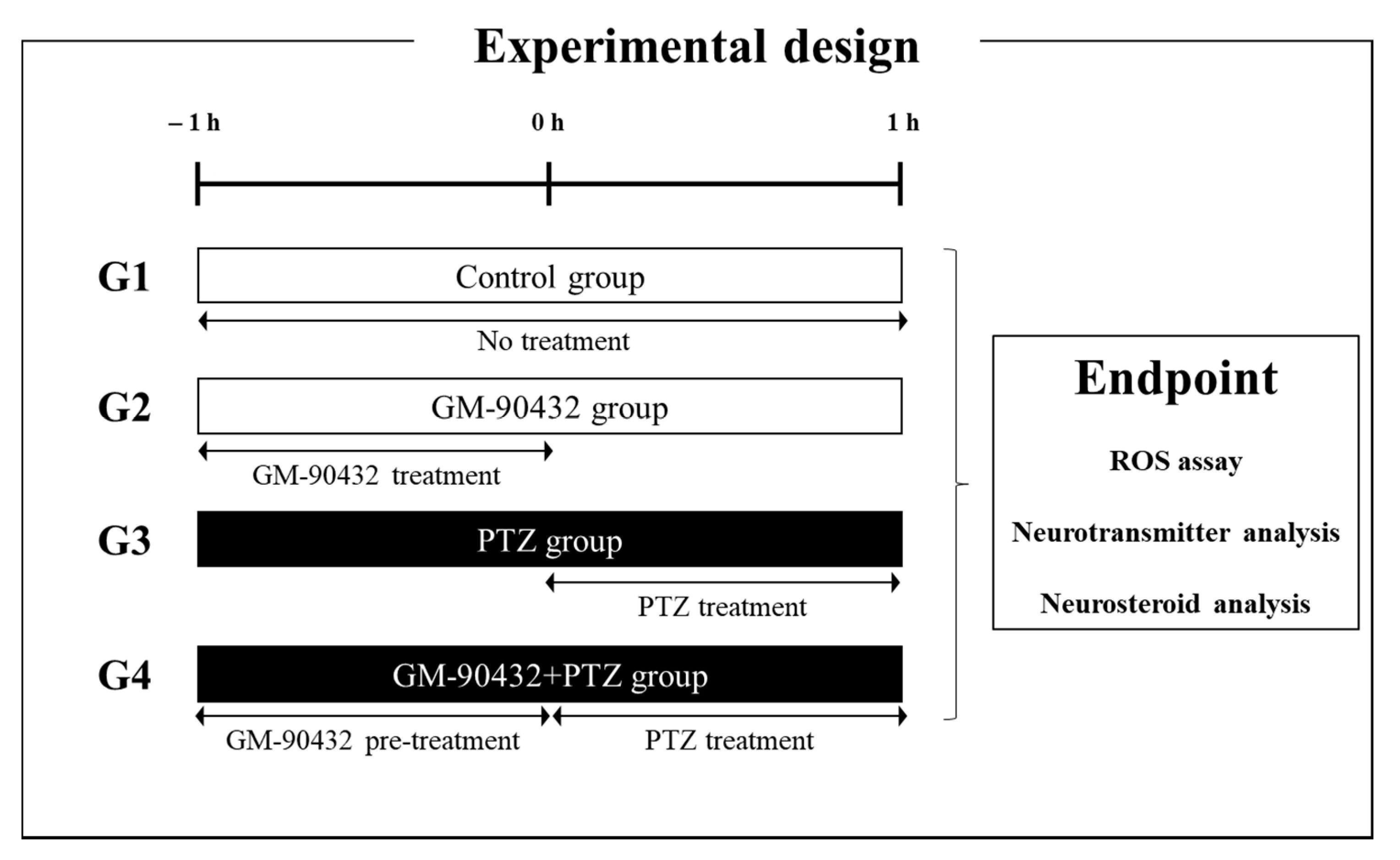
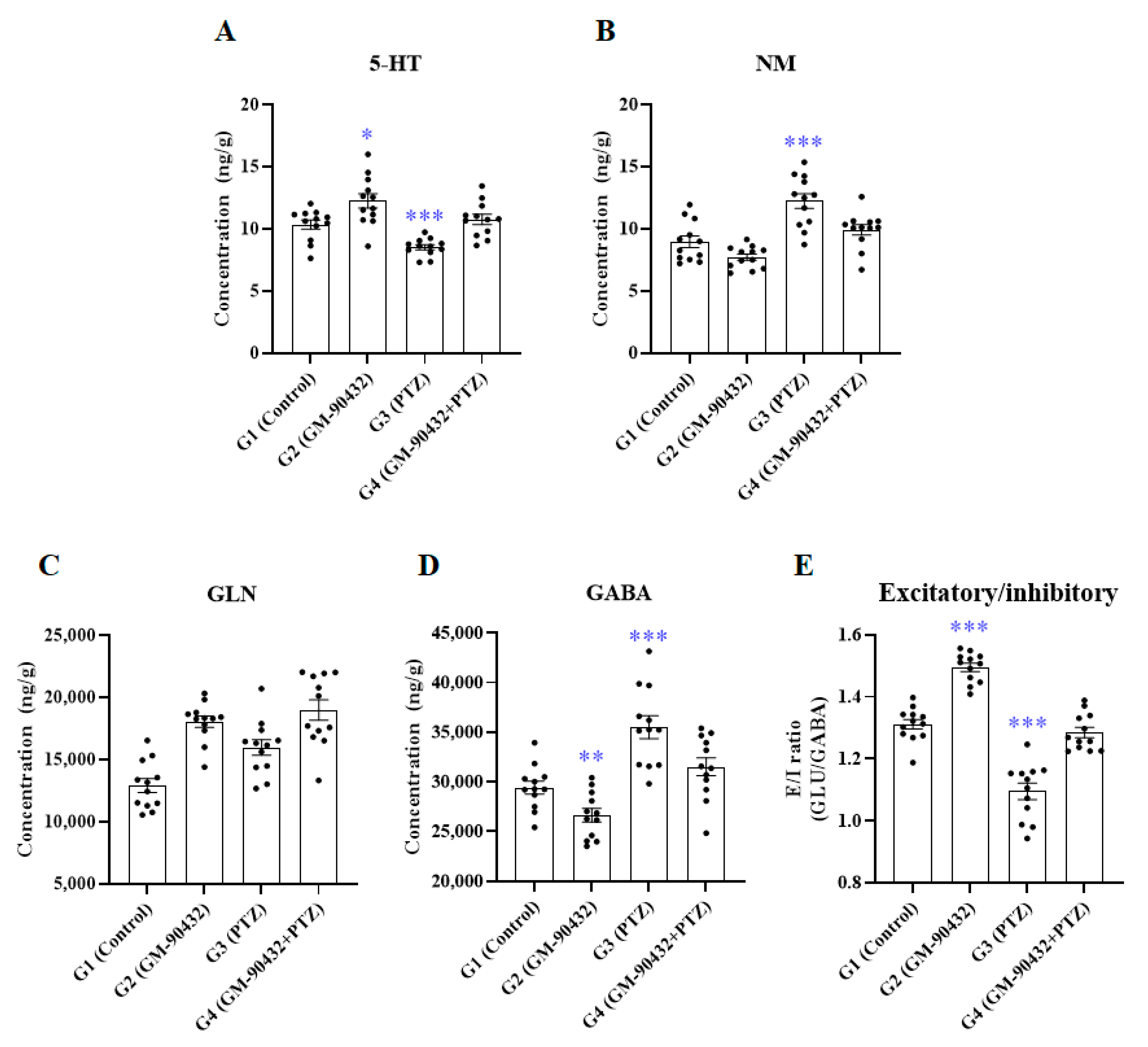
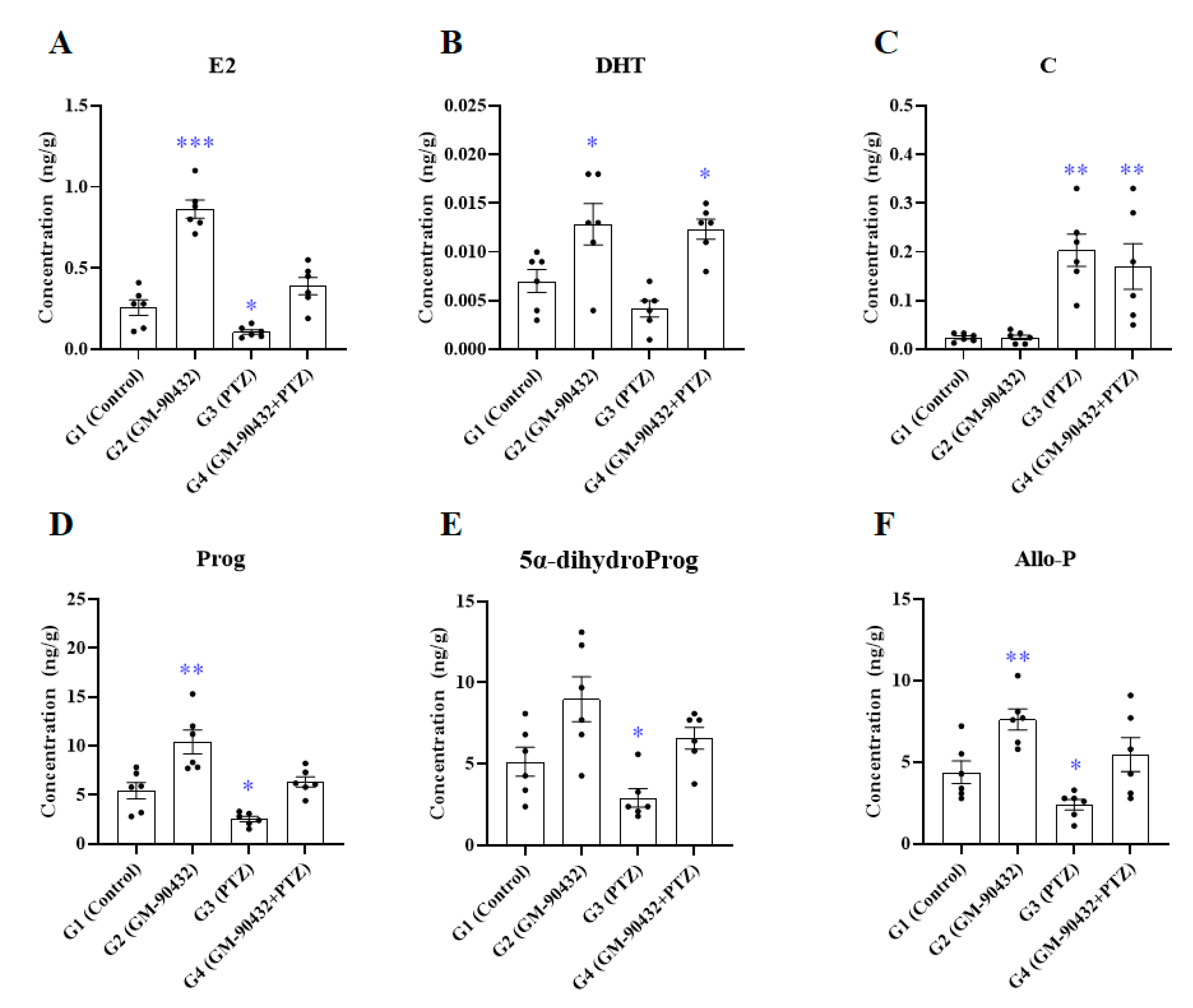
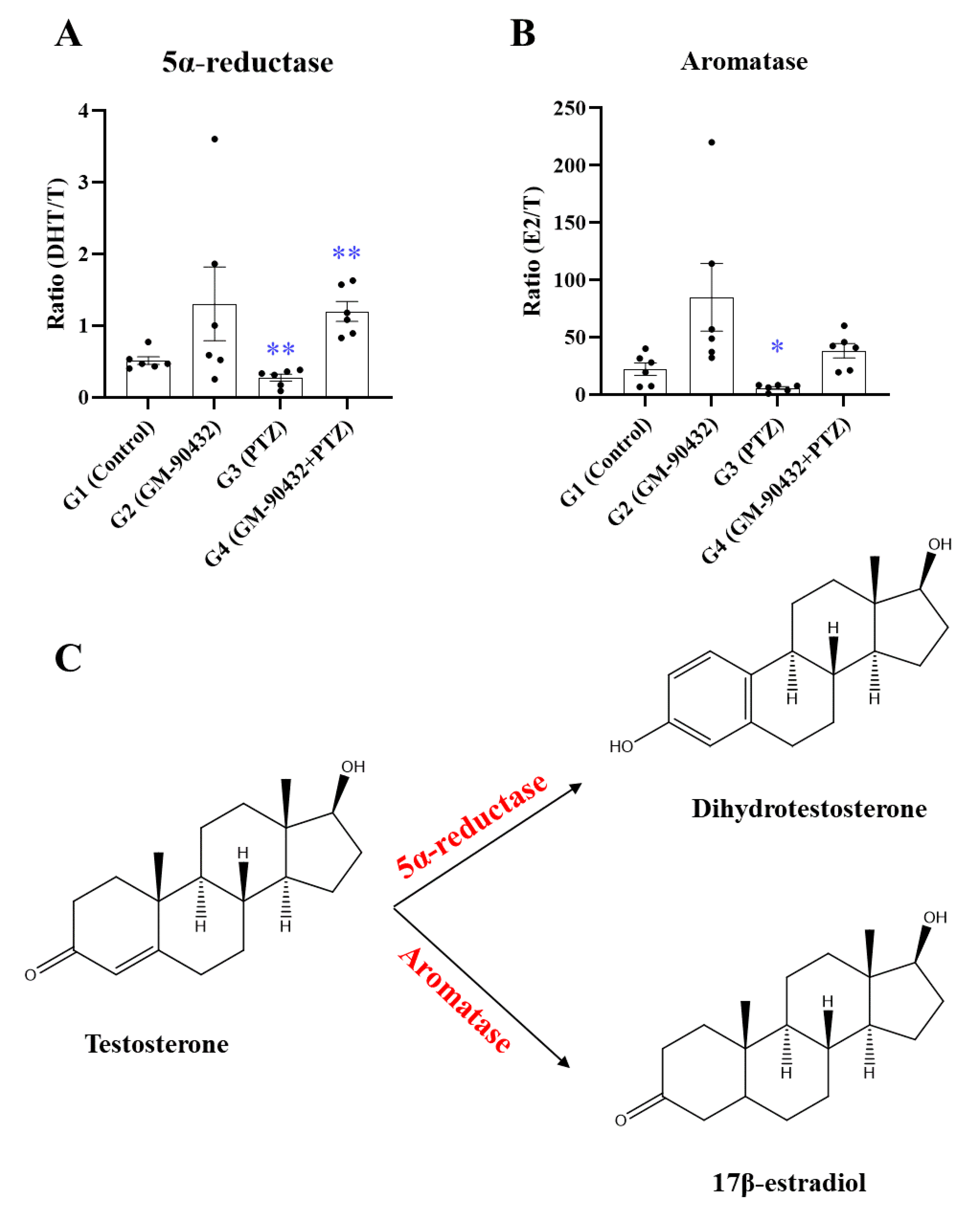
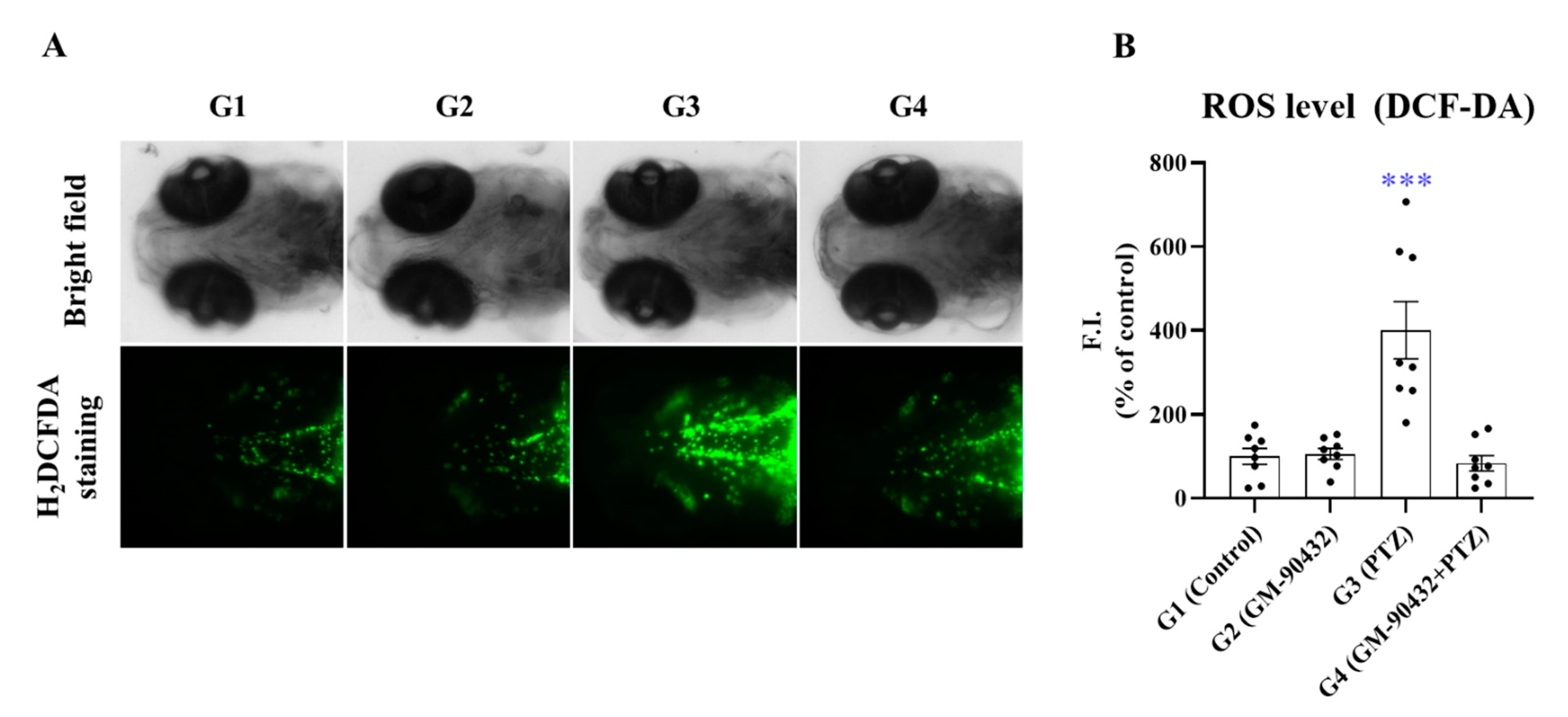
Publisher’s Note: MDPI stays neutral with regard to jurisdictional claims in published maps and institutional affiliations. |
© 2021 by the authors. Licensee MDPI, Basel, Switzerland. This article is an open access article distributed under the terms and conditions of the Creative Commons Attribution (CC BY) license (http://creativecommons.org/licenses/by/4.0/).
Share and Cite
Kim, S.S.; Kan, H.; Hwang, K.-S.; Yang, J.Y.; Son, Y.; Shin, D.-S.; Lee, B.H.; Ahn, S.H.; Ahn, J.H.; Cho, S.-H.; et al. Neurochemical Effects of 4-(2Chloro-4-Fluorobenzyl)-3-(2-Thienyl)-1,2,4-Oxadiazol-5(4H)-One in the Pentylenetetrazole (PTZ)-Induced Epileptic Seizure Zebrafish Model. Int. J. Mol. Sci. 2021, 22, 1285. https://doi.org/10.3390/ijms22031285
Kim SS, Kan H, Hwang K-S, Yang JY, Son Y, Shin D-S, Lee BH, Ahn SH, Ahn JH, Cho S-H, et al. Neurochemical Effects of 4-(2Chloro-4-Fluorobenzyl)-3-(2-Thienyl)-1,2,4-Oxadiazol-5(4H)-One in the Pentylenetetrazole (PTZ)-Induced Epileptic Seizure Zebrafish Model. International Journal of Molecular Sciences. 2021; 22(3):1285. https://doi.org/10.3390/ijms22031285
Chicago/Turabian StyleKim, Seong Soon, Hyemin Kan, Kyu-Seok Hwang, Jung Yoon Yang, Yuji Son, Dae-Seop Shin, Byung Hoi Lee, Se Hwan Ahn, Jin Hee Ahn, Sung-Hee Cho, and et al. 2021. "Neurochemical Effects of 4-(2Chloro-4-Fluorobenzyl)-3-(2-Thienyl)-1,2,4-Oxadiazol-5(4H)-One in the Pentylenetetrazole (PTZ)-Induced Epileptic Seizure Zebrafish Model" International Journal of Molecular Sciences 22, no. 3: 1285. https://doi.org/10.3390/ijms22031285
APA StyleKim, S. S., Kan, H., Hwang, K.-S., Yang, J. Y., Son, Y., Shin, D.-S., Lee, B. H., Ahn, S. H., Ahn, J. H., Cho, S.-H., & Bae, M. A. (2021). Neurochemical Effects of 4-(2Chloro-4-Fluorobenzyl)-3-(2-Thienyl)-1,2,4-Oxadiazol-5(4H)-One in the Pentylenetetrazole (PTZ)-Induced Epileptic Seizure Zebrafish Model. International Journal of Molecular Sciences, 22(3), 1285. https://doi.org/10.3390/ijms22031285




